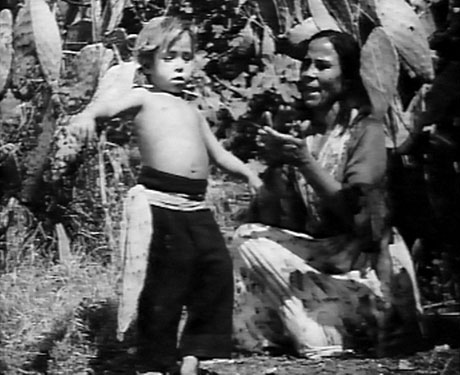| Brussels 1958 - Aguaespejo granadino: An experimental film par excellence |
The technique developed here constitutes a faithful crystallization of the theme being addressed. In fact, it has been conceived and exists in order to express it.
Diaphony, the principal technical innovation, has been revealed to the world for the first time in this experimental short film.
Diaphony is the opposite of stereophony. It seeks psychological and chronological relief. Diaphony is grounded in the past (behind the spectator, at the back of the auditorium) and in the future (on the screen, in front of the spectator). In their intersection, these two sound sources define the present (where the spectator is).
The audience is thus positioned in such a way as to see and hear everything that happens on the screen. At the same time, however, they are under the influence of subconscious cries that stimulate, by way of psychological reflexes, their opinions, their reactions and their effective participation in the spectacle, thanks to a basic programme of stimuli.
The exact position of the sound sources that convert the counter-field of the screen into a counter-point and a chronological counter-time is of the greatest importance.
Diaphony is a formula patented by the filmmaker in 1944. It was completed, successively, in 1948, 1953 and 1957, with a set of four registered patents, all his own absolutely original inventions, at a time when only stereo, in the best of cases, was receiving much attention.
The filmmaker has selected more than five hundred sounds for a screening lasting twenty minutes, and has mixed these to merge them in the concrete music that is transmitted.
To do this, the filmmaker himself had to construct all of the elements of this new technique, from the machine for perforating the synchronous 1/4-inch tape to the recording equipment, the reverberators, the mixers and the toothed players.
Similarly, the effects of the synchronous polarizers on the sheets of water, on the skies, and on the sheens or sparkles; these have been mounted on Askania apparatus.
Some of the optical effects have also been produced using a new system of water lenses.
However, the filmmaker wishes to let us know, above all, that the technical efforts remain eclipsed by his sole intention: to transmit, poetically, the mystical love he feels for his native land, Granada.
THEME – Simple, free of any kind of tourist photography, Granada is presented as it is in itself. Disturbed by the pulsing of its ECSTASY between East and West, living the dream of unreal gravity of its verdure...
Of the water... A profound love... ''Phantasm''... A dead life, enamoured of the mirroring reflection, rises, vertically distended, from the depths of the night of the pools, toward the transparent and haughty azure.
The water fountains of the Generalife and the Alhambra. Aquatic reflections of human life. Instants in suspension in a capricious mathematics. Forms of the illusion of ascent and the reality of the fall.
To the eternal cyclical rhythm of the Great Siguiriya, the blind creatures that live on dry land dance...

^ | | | Berlin 1956 |
| Brussels 1958 |
|